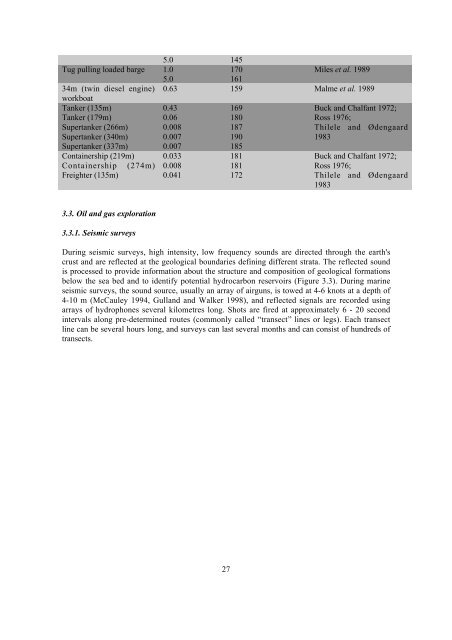Oceans of noise - Whale and Dolphin Conservation Society
Oceans of noise - Whale and Dolphin Conservation Society
Oceans of noise - Whale and Dolphin Conservation Society
You also want an ePaper? Increase the reach of your titles
YUMPU automatically turns print PDFs into web optimized ePapers that Google loves.
5.0 145<br />
Tug pulling loaded barge 1.0<br />
170<br />
Miles et al. 1989<br />
5.0<br />
161<br />
34m (twin diesel engine)<br />
workboat<br />
0.63 159 Malme et al. 1989<br />
Tanker (135m)<br />
0.43<br />
169<br />
Buck <strong>and</strong> Chalfant 1972;<br />
Tanker (179m)<br />
0.06<br />
180<br />
Ross 1976;<br />
Supertanker (266m) 0.008<br />
187<br />
Thilele <strong>and</strong> Ødengaard<br />
Supertanker (340m) 0.007<br />
190<br />
1983<br />
Supertanker (337m) 0.007<br />
185<br />
Containership (219m) 0.033<br />
181<br />
Buck <strong>and</strong> Chalfant 1972;<br />
Containership (274m) 0.008<br />
181<br />
Ross 1976;<br />
Freighter (135m)<br />
0.041<br />
172<br />
Thilele <strong>and</strong> Ødengaard<br />
1983<br />
3.3. Oil <strong>and</strong> gas exploration<br />
3.3.1. Seismic surveys<br />
During seismic surveys, high intensity, low frequency sounds are directed through the earth's<br />
crust <strong>and</strong> are reflected at the geological boundaries defining different strata. The reflected sound<br />
is processed to provide information about the structure <strong>and</strong> composition <strong>of</strong> geological formations<br />
below the sea bed <strong>and</strong> to identify potential hydrocarbon reservoirs (Figure 3.3). During marine<br />
seismic surveys, the sound source, usually an array <strong>of</strong> airguns, is towed at 4-6 knots at a depth <strong>of</strong><br />
4-10 m (McCauley 1994, Gull<strong>and</strong> <strong>and</strong> Walker 1998), <strong>and</strong> reflected signals are recorded using<br />
arrays <strong>of</strong> hydrophones several kilometres long. Shots are fired at approximately 6 - 20 second<br />
intervals along pre-determined routes (commonly called “transect” lines or legs). Each transect<br />
line can be several hours long, <strong>and</strong> surveys can last several months <strong>and</strong> can consist <strong>of</strong> hundreds <strong>of</strong><br />
transects.<br />
27

















